产业组织理论-the theory of the firm
- 格式:pdf
- 大小:147.10 KB
- 文档页数:16
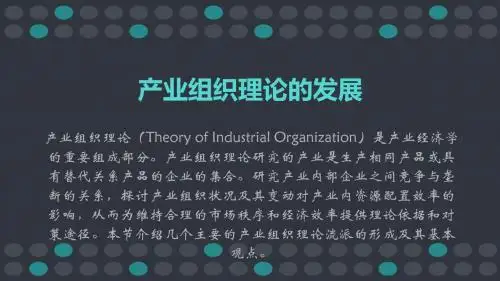
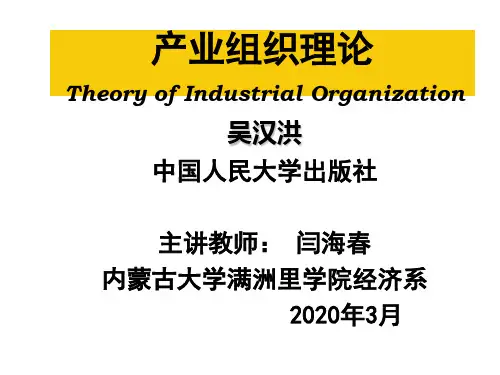
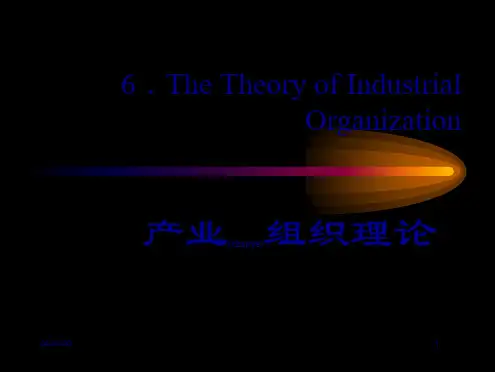
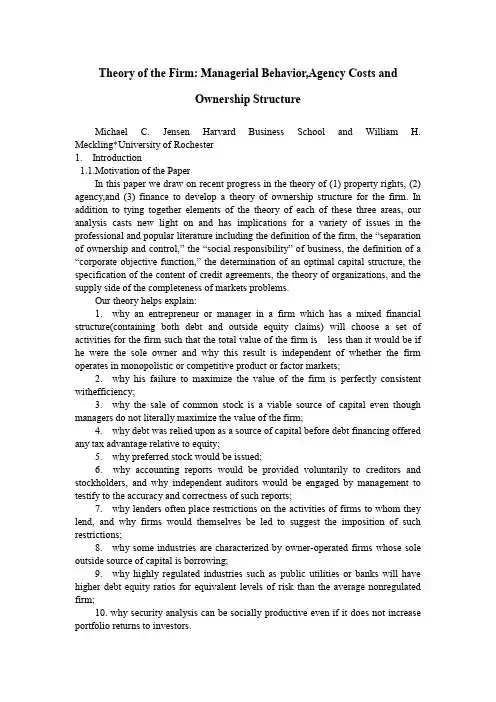
Theory of the Firm: Managerial Behavior,Agency Costs andOwnership StructureMichael C. Jensen Harvard Business School and William H. Meckling*University of Rochester1. Introduction1.1.Motivation of the PaperIn this paper we draw on recent progress in the theory of (1) property rights, (2) agency,and (3) finance to develop a theory of ownership structure for the firm. In addition to tying together elements of the theory of each of these three areas, our analysis casts new light on and has implications for a variety of issues in the professional and popular literature including the definition of the firm, the “separation of ownership and control,” the “social responsibility” of business, the definition of a “corporate objective function,” the determination of an optimal capital structure, the specification of the content of credit agreements, the theory of organizations, and the supply side of the completeness of markets problems.Our theory helps explain:1. why an entrepreneur or manager in a firm which has a mixed financial structure(containing both debt and outside equity claims) will choose a set of activities for the firm such that the total value of the firm is less than it would be if he were the sole owner and why this result is independent of whether the firm operates in monopolistic or competitive product or factor markets;2. why his failure to maximize the value of the firm is perfectly consistent withefficiency;3. why the sale of common stock is a viable source of capital even though managers do not literally maximize the value of the firm;4. why debt was relied upon as a source of capital before debt financing offered any tax advantage relative to equity;5. why preferred stock would be issued;6. why accounting reports would be provided voluntarily to creditors and stockholders, and why independent auditors would be engaged by management to testify to the accuracy and correctness of such reports;7. why lenders often place restrictions on the activities of firms to whom they lend, and why firms would themselves be led to suggest the imposition of such restrictions;8. why some industries are characterized by owner-operated firms whose sole outside source of capital is borrowing;9. why highly regulated industries such as public utilities or banks will have higher debt equity ratios for equivalent levels of risk than the average nonregulated firm;10. why security analysis can be socially productive even if it does not increase portfolio returns to investors.1.2 Theory of the Firm: An Empty Box?While the literature of economics is replete with references to the “theory of the firm,” the material generally subsumed under that heading is not actually a theory of the firm but rather a theory of markets in which firms are important actors. The firm is a “black box” operated so as to meet the relevant marginal conditions with respect to inputs and outputs, thereby maximizing profits, or more accurately, present value. Except for a few recent and tentative steps, however,we have no theory which explains how the conflicting objectives of the individual participants are brought into equilibrium so as to yield this result. The limitations of this black box view of the firm have been cited by Adam Smith and Alfred Marshall, among others. More recently, popular and professional debates over the “social responsibility” of corporations, the separation of ownership and control, and the rash of reviews of the literature on the “theory of the firm” have evidenced continuing concern with these issues.A number of major attempts have been made during recent years to construct a theory of the firm by substituting other models for profit or value maximization, with each attempt motivated by a conviction that the latter is inadequate to explain managerial behavior in large corporations. Some of these reformulation attempts have rejected the fundamental principle of maximizingbehavior as well as rejecting the more specific profit-maximizing model. We retain the notion of maximizing behavior on the part of all individuals in the analysis that follows.1.3 Property RightsAn independent stream of research with important implications for the theory of the firm has been stimulated by the pioneering work of Coase, and extended by Alchian, Demsetz, and others. A comprehensive survey of this literature is given by Furubotn and Pejovich (1972).While the focus of this research has been “property rights”,the subject matter encompassed is far broader than that term suggests. What is important for the problems addressed here is that specification of individual rights determines how costs and rewards will be allocated among the participants in any organization. Since the specification of rights is generally affected through contracting (implicit as well as explicit), individual behavior in organizations, including the behavior of managers, will depend upon the nature of these contracts. We focus in this paper on the behavioral implications of the property rights specified in the contracts between the owners and managers of the firm.1.4 Agency CostsMany problems associated with the inadequacy of the current theory of the firm can also be viewed as special cases of the theory of agency relationships in which there is a growing literature. This literature has developed independently of the property rights literature even though the problems with which it is concerned are similar; the approaches are in fact highly complementary to each other.We define an agency relationship as a contract under which one or more persons (the principal(s)) engage another person (the agent) to perform some service on their behalf which involves delegating some decision making authority to the agent. If both parties to the relationship are utility maximizers, there is good reason to believe that the agent will not always act in the best interests of the principal. Theprincipal can limit divergences from his interest by establishing appropriate incentives for the agent and by incurring monitoring costs designed to limit the aberrant activities of the agent. In addition in some situations it will pay the agent to expend resources (bonding costs) to guarantee that he will not take certain actions which would harm the principal or to ensure that the principal will be compensated if he does take such actions. However, it is generally impossible for the principal or the agent at zero cost to ensure that the agent will make optimal decisions from the principal’s viewpoint. In most agency relationships the principal and the agent will incur positive monitoring and bonding costs (non-pecuniary as well as pecuniary), and in addition there will be some divergence between the agent’s decisions and those decisions which would maximize the welfare of the principal. The dollar equivalent of the reduction in welfare experienced by the principal as a result of this divergence is also a cost of the agency relationship, and we refer to this latter cost as the “residual loss.” We define agency costs as the sum of:1. the monitoring expenditures by the principal,2. the bonding expenditures by the agent,3. the residual loss.Note also that agency costs arise in any situation involving cooperative effort (such as the coauthoring of this paper) by two or more people even though there is no clear-cut principal-agent relationship. Viewed in this light it is clear that our definition of agency costs and their importance to the theory of the firm bears a close relationship to the problem of shirking and monitoring of team production which Alchian and Demsetz (1972) raise in their paper on the theory of the firm.Since the relationship between the stockholders and the managers of a corporation fits the definition of a pure agency relationship, it should come as no surprise to discover that the issues associated with the “separation of ownership and control” in the modern diffuse ownership corporation are intimately associated with the general problem of agency. We show below that an explanation of why and how the agency costs generated by the corporate form are born leads to a theory of the ownership (or capital) structure of the firm.Before moving on, however, it is worthwhile to point out the generality of the agency problem. The problem of inducing an “agent” to behave as if he were maximizing the “principal’s” welfare is quite general. It exists in all organizations and in all cooperative efforts—at every level of management in firms, in universities, in mutual companies, in cooperatives, in governmental authorities and bureaus, in unions, and in relationships normally classified as agency relationships such as those common in the performing arts and the market for real estate. The development of theories to explain the form which agency costs take in each of these situations (where the contractual relations differ significantly), and how and why they are born will lead to a rich theory of organizations which is now lacking in economics and the social sciences generally.We confine our attention in this paper to only a small part of this general problem—the analysis of agency costs generated by the contractual arrangements between the owners and top management of the corporation.Our approach to the agency problem here differs fundamentally from most of theexisting literature. That literature focuses almost exclusively on the normative aspects of the agency relationship; that is, how to structure the contractual relation (including compensation incentives) between the principal and agent to provide appropriate incentives for the agent to make choices which will maximize the principal’s welfare, given that uncertainty and imperfect monitoring exist.We focus almost entirely on the positive aspects of the theory. That is, we assume individuals solve these normative problems, and given that only stocks and bonds can be issued as claims, we investigate the incentives faced by each of the parties and the elements entering into the determination of the equilibrium contractual form characterizing the relationship between the manager (i.e., agent) of the firm and the outside equity and debt holders (i.e., principals).1.5 General Comments on the Definition of the firmRonald Coase in his seminal paper entitled “The Nature of the Firm” (1937) pointed out that economics had no positive theory to determine the bounds of the firm. He characterized the bounds of the firm as that range of exchanges over which the market system was suppressed and where resource allocation was accomplished instead by authority and direction. He focused on the cost of using markets to effect contracts and exchanges and argued that activities would be included within the firm whenever the costs of using markets were greater than the costs of using direct authority. Alchian and Demsetz (1972) object to the notion that activities within the firm are governed by authority, and correctly emphasize the role of contracts as a vehicle for voluntary exchange. They emphasize the role of monitoring in situations in which there is joint input or team production.We are sympathetic to with the importance they attach to monitoring, but we believe the emphasis that Alchian and Demsetz place on joint input production is too narrow and therefore misleading. Contractual relations are the essence of the firm, not only with employees but with suppliers, customers, creditors, and so on. The problem of agency costs and monitoring exists for all of these contracts, independent of whether there is joint production in their sense; i.e., joint production can explain only a small fraction of the behavior of individuals associated with a firm.It is important to recognize that most organizations are simply legal fictions which serve as a nexus for a set of contracting relationships among individuals. This includes firms, non-profit institutions such as universities, hospitals, and foundations, mutual organizations such as mutual savings banks and insurance companies and co-operatives, some private clubs, and even governmental bodies such as cities, states, and the federal government, government enterprises such as TV A, the Post Office, transit systems, and so forth.The private corporation or firm is simply one form of legal fiction which serves as a nexus for contracting relationships and which is also characterized by the existence of divisible residual claims on the assets and cash flows of the organization which can generally be sold without permission of the other contracting individuals. Although this definition of the firm has little substantive content, emphasizing the essential contractual nature of firms and other organizations focuses attention on a crucial set of questions—why particular sets of contractual relations arise for varioustypes of organizations, what the consequences of these contractual relations are, and how they are affected by changes exogenous to the organization. Viewed this way, it makes little or no sense to try to distinguish those things that are “inside” the firm (or any other organization) from those things that are “outside” of it. There is in a very real sense only a multitude of complex relationships (i.e.,contracts) between the legal fiction (the firm) and the owners of labor, material and capital inputs and the consumers of output.Viewing the firm as the nexus of a set of contracting relationships among individuals also serves to make it clear that the personalization of the firm implied by asking questions such as “what should be the objective function of the firm?” or “does the firm have a social responsibility?” is seriously misleading. The firm is not an individual. It is a legal fiction which serves as a focus for a complex process in which the conflicting objectives of individuals (some of whom may “represent” other organizations) are brought into equilibrium within a framework of contractual relations. In this sense the “behavior” of the firm is like the behavior of a market, that is, the outcome of a complex equilibrium process. We seldom fall into the trap of characterizing the wheat or stock market as an individual, but we often make this error by thinking about organizations as if they were persons with motivations and intentions.1.6 Overview of the PaperWe develop our theory in stages. Sections 2 and 4 provide analyses of the agency costs of equity and debt respectively. These form the major foundation of the theory. In Section 3, we pose some questions regarding the existence of the corporate form of organization and examines the role of limited liability. Section 5 provides a synthesis of the basic concepts derived in sections 2-4 into a theory of the corporate ownership structure which takes account of the trade-offs available to the entrepreneur-manager between inside and outside equity and debt. Some qualifications and extensions of the analysis are discussed in section 6, and section 7 contains a brief summary and conclusions.企业理论:管理行为,代理成本和所有权结构迈克尔詹森哈佛商学院和威廉H.麦克林罗切斯特大学1.简介1.1.研究背景在本文中,我们借鉴在产权,机构,以及金融方面的最新成果,希望可以发展一种所有制结构的企业理论。

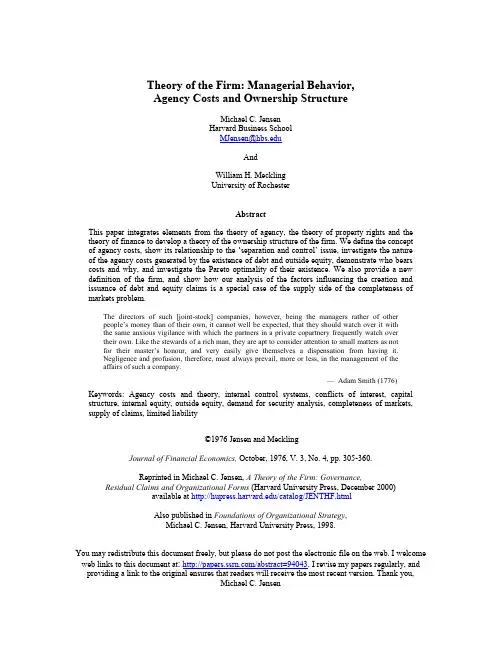
Theory of the Firm: Managerial Behavior,Agency Costs and Ownership StructureMichael C. JensenHarvard Business SchoolMJensen@AndWilliam H. MecklingUniversity of RochesterAbstractThis paper integrates elements from the theory of agency, the theory of property rights and the theory of finance to develop a theory of the ownership structure of the firm. We define the concept of agency costs, show its relationship to the ‘separation and control’ issue, investigate the nature of the agency costs generated by the existence of debt and outside equity, demonstrate who bears costs and why, and investigate the Pareto optimality of their existence. We also provide a new definition of the firm, and show how our analysis of the factors influencing the creation and issuance of debt and equity claims is a special case of the supply side of the completeness of markets problem.The directors of such [joint-stock] companies, however, being the managers rather of otherpeople’s money than of their own, it cannot well be expected, that they should watch over it withthe same anxious vigilance with which the partners in a private copartnery frequently watch overtheir own. Like the stewards of a rich man, they are apt to consider attention to small matters as notfor their master’s honour, and very easily give themselves a dispensation from having it.Negligence and profusion, therefore, must always prevail, more or less, in the management of theaffairs of such a company.— Adam Smith (1776) Keywords: Agency costs and theory, internal control systems, conflicts of interest, capital structure, internal equity, outside equity, demand for security analysis, completeness of markets, supply of claims, limited liability©1976 Jensen and MecklingJournal of Financial Economics, October, 1976, V. 3, No. 4, pp. 305-360.Reprinted in Michael C. Jensen, A Theory of the Firm: Governance,Residual Claims and Organizational Forms (Harvard University Press, December 2000)available at /catalog/JENTHF.htmlAlso published in Foundations of Organizational Strategy,Michael C. Jensen, Harvard University Press, 1998.You may redistribute this document freely, but please do not post the electronic file on the web. I welcome web links to this document at: /abstract=94043. I revise my papers regularly, and providing a link to the original ensures that readers will receive the most recent version. Thank you,Michael C. JensenTheory of the Firm: Managerial Behavior,Agency Costs and Ownership StructureMichael C. JensenHarvard Business SchoolandWilliam H. Meckling*University of Rochester1. Introduction1.1.Motivation of the PaperIn this paper we draw on recent progress in the theory of (1) property rights, (2) agency, and (3) finance to develop a theory of ownership structure1 for the firm. In addition to tying together elements of the theory of each of these three areas, our analysis casts new light on and has implications for a variety of issues in the professional and popular literature including the definition of the firm, the “separation of ownership and control,” the “social responsibility” of business, the definition of a “corporate objective function,” the determination of an optimal capital structure, the specification of the content of credit agreements, the theory of organizations, and the supply side of the completeness of markets problems.1 We do not use the term ‘capital structure’ because that term usually denotes the relative quantities of bonds, equity, warrants, trade credit, etc., which represent the liabilities of a firm. Our theory implies there is another important dimension to this problem—namely the relative amount of ownership claims held by insiders (management) and outsiders (investors with no direct role in the management of the firm).* Associate Professor and Dean, respectively, Graduate School of Management, University of Rochester. An earlier version of this paper was presented at the Conference on Analysis and Ideology, Interlaken, Switzerland, June 1974, sponsored by the Center for Research in Government Policy and Business at the University of Rochester, Graduate School of Management. We are indebted to F. Black, E. Fama, R. Ibbotson, W. Klein, M. Rozeff, R. Weil, O. Williamson, an anonymous referee, and to our colleagues and members of the Finance Workshop at the University of Rochester for their comments and criticisms, in particular G. Benston, M. Canes, D. Henderson, K. Leffler, J. Long, C. Smith, R. Thompson, R. Watts, and J. Zimmerman.Our theory helps explain:1.why an entrepreneur or manager in a firm which has a mixed financial structure(containing both debt and outside equity claims) will choose a set of activities for the firm such that the total value of the firm is less than it would be if he were the sole owner and why this result is independent of whether the firm operates in monopolistic or competitive product or factor markets;2.why his failure to maximize the value of the firm is perfectly consistent withefficiency;3.why the sale of common stock is a viable source of capital even though managers donot literally maximize the value of the firm;4.why debt was relied upon as a source of capital before debt financing offered any taxadvantage relative to equity;5.why preferred stock would be issued;6.why accounting reports would be provided voluntarily to creditors and stockholders,and why independent auditors would be engaged by management to testify to the accuracy and correctness of such reports;7.why lenders often place restrictions on the activities of firms to whom they lend, andwhy firms would themselves be led to suggest the imposition of such restrictions;8.why some industries are characterized by owner-operated firms whose sole outsidesource of capital is borrowing;9.why highly regulated industries such as public utilities or banks will have higher debtequity ratios for equivalent levels of risk than the average nonregulated firm;10.why security analysis can be socially productive even if it does not increase portfolioreturns to investors.1.2Theory of the Firm: An Empty Box?While the literature of economics is replete with references to the “theory of the firm,”the material generally subsumed under that heading is not actually a theory of the firm but rather a theory of markets in which firms are important actors. The firm is a “black box” operated so as to meet the relevant marginal conditions with respect to inputs and outputs, thereby maximizing profits, or more accurately, present value. Except for a few recent and tentative steps, however, we have no theory which explains how the conflicting objectives of the individual participants are brought into equilibrium so as to yield this result. The limitations of this black box view of the firm have been cited by Adam Smith and Alfred Marshall, among others. More recently, popular and professional debates over the “social responsibility” of corporations, the separation of ownership and control, and the rash of reviews of the literature on the “theory of the firm” have evidenced continuing concern with these issues.2A number of major attempts have been made during recent years to construct a theory of the firm by substituting other models for profit or value maximization, with each attempt motivated by a conviction that the latter is inadequate to explain managerial behavior in large corporations.3 Some of these reformulation attempts have rejected the fundamental principle of maximizing2 Reviews of this literature are given by Peterson (1965), Alchian (1965, 1968), Machlup (1967), Shubik (1970), Cyert and Hedrick (1972), Branch (1973), Preston (1975).3 See Williamson (1964, 1970, 1975), Marris (1964), Baumol (1959), Penrose (1958), and Cyert and March (1963). Thorough reviews of these and other contributions are given by Machlup (1967) and Alchian (1965).Simon (1955) developed a model of human choice incorporating information (search) and computational costs which also has important implications for the behavior of managers. Unfortunately, Simon’s work has often been misinterpreted as a denial of maximizing behavior, and misused, especially in the marketing and behavioral science literature. His later use of the term “satisficing” (Simon, 1959) has undoubtedly contributed to this confusion because it suggests rejection of maximizing behavior rather than maximization subject to costs of information and of decision making.behavior as well as rejecting the more specific profit-maximizing model. We retain the notion of maximizing behavior on the part of all individuals in the analysis that follows.41.3Property RightsAn independent stream of research with important implications for the theory of the firm has been stimulated by the pioneering work of Coase, and extended by Alchian, Demsetz, and others.5 A comprehensive survey of this literature is given by Furubotn and Pejovich (1972). While the focus of this research has been “property rights”,6 the subject matter encompassed is far broader than that term suggests. What is important for the problems addressed here is that specification of individual rights determines how costs and rewards will be allocated among the participants in any organization. Since the specification of rights is generally affected through contracting (implicit as well as explicit), individual behavior in organizations, including the behavior of managers, will depend upon the nature of these contracts. We focus in this paper on the behavioral implications of the property rights specified in the contracts between the owners and managers of the firm.1.4Agency CostsMany problems associated with the inadequacy of the current theory of the firm can also be viewed as special cases of the theory of agency relationships in which there is a growing4 See Meckling (1976) for a discussion of the fundamental importance of the assumption of resourceful, evaluative, maximizing behavior on the part of individuals in the development of theory. Klein (1976) takes an approach similar to the one we embark on in this paper in his review of the theory of the firm and the law.5 See Coase (1937, 1959, 1960), Alchian (1965, 1968), Alchian and Kessel (1962), Demsetz (1967), Alchian and Demsetz (1972), Monson and Downs (1965), Silver and Auster (1969), and McManus (1975).6 Property rights are of course human rights, i.e., rights which are possessed by human beings. The introduction of the wholly false distinction between property rights and human rights in many policy discussions is surely one of the all time great semantic flimflams.literature.7 This literature has developed independently of the property rights literature even though the problems with which it is concerned are similar; the approaches are in fact highly complementary to each other.We define an agency relationship as a contract under which one or more persons (the principal(s)) engage another person (the agent) to perform some service on their behalf which involves delegating some decision making authority to the agent. If both parties to the relationship are utility maximizers, there is good reason to believe that the agent will not always act in the best interests of the principal. The principal can limit divergences from his interest by establishing appropriate incentives for the agent and by incurring monitoring costs designed to limit the aberrant activities of the agent. In addition in some situations it will pay the agent to expend resources (bonding costs) to guarantee that he will not take certain actions which would harm the principal or to ensure that the principal will be compensated if he does take such actions. However, it is generally impossible for the principal or the agent at zero cost to ensure that the agent will make optimal decisions from the principal’s viewpoint. In most agency relationships the principal and the agent will incur positive monitoring and bonding costs (non-pecuniary as well as pecuniary), and in addition there will be some divergence between the agent’s decisions8 and those decisions which would maximize the welfare of the principal. The dollar equivalent of the reduction in welfare experienced by the principal as a result of this divergence is also a cost of the agency relationship, and we refer to this latter cost as the “residual loss.” We define agency costs as the sum of:7 Cf. Berhold (1971), Ross (1973, 1974a), Wilson (1968, 1969), and Heckerman (1975).8 Given the optimal monitoring and bonding activities by the principal and agent.1.the monitoring expenditures by the principal,92.the bonding expenditures by the agent,3.the residual loss.Note also that agency costs arise in any situation involving cooperative effort (such as the co-authoring of this paper) by two or more people even though there is no clear-cut principal-agent relationship. Viewed in this light it is clear that our definition of agency costs and their importance to the theory of the firm bears a close relationship to the problem of shirking and monitoring of team production which Alchian and Demsetz (1972) raise in their paper on the theory of the firm.Since the relationship between the stockholders and the managers of a corporation fits the definition of a pure agency relationship, it should come as no surprise to discover that the issues associated with the “separation of ownership and control” in the modern diffuse ownership corporation are intimately associated with the general problem of agency. We show below that an explanation of why and how the agency costs generated by the corporate form are born leads to a theory of the ownership (or capital) structure of the firm.Before moving on, however, it is worthwhile to point out the generality of the agency problem. The problem of inducing an “agent” to behave as if he were maximizing the “principal’s” welfare is quite general. It exists in all organizations and in all cooperative efforts—at every level of management in firms,10 in universities, in mutual companies, in cooperatives, in9 As it is used in this paper the term monitoring includes more than just measuring or observing the behavior of the agent. It includes efforts on the part of the principal to ‘control’ the behavior of the agent through budget restrictions, compensation policies, operating rules, etc.10 As we show below the existence of positive monitoring and bonding costs will result in the manager of a corporation possessing control over some resources which he can allocate (within certain constraints) to satisfy his own preferences. However, to the extent that he must obtain the cooperation of others in order to carry out his tasks (such as divisional vice presidents) and to the extent that he cannot control their behavior perfectly and costlessly they will be able to appropriate some of these resources for their own ends. In short, there are agency costs generated at every level of the organization. Unfortunately, the analysis of these more general organizational issues is even more difficult than that of the ‘ownership andgovernmental authorities and bureaus, in unions, and in relationships normally classified as agency relationships such as those common in the performing arts and the market for real estate. The development of theories to explain the form which agency costs take in each of these situations (where the contractual relations differ significantly), and how and why they are born will lead to a rich theory of organizations which is now lacking in economics and the social sciences generally. We confine our attention in this paper to only a small part of this general problem—the analysis of agency costs generated by the contractual arrangements between the owners and top management of the corporation.Our approach to the agency problem here differs fundamentally from most of the existing literature. That literature focuses almost exclusively on the normative aspects of the agency relationship; that is, how to structure the contractual relation (including compensation incentives) between the principal and agent to provide appropriate incentives for the agent to make choices which will maximize the principal’s welfare, given that uncertainty and imperfect monitoring exist. We focus almost entirely on the positive aspects of the theory. That is, we assume individuals solve these normative problems, and given that only stocks and bonds can be issued as claims, we investigate the incentives faced by each of the parties and the elements entering into the determination of the equilibrium contractual form characterizing the relationship between the manager (i.e., agent) of the firm and the outside equity and debt holders (i.e., principals).1.5General Comments on the Definition of the firmRonald Coase in his seminal paper entitled “The Nature of the Firm” (1937) pointed out that economics had no positive theory to determine the bounds of the firm. He characterized thecontrol’ issue because the nature of the contractual obligations and rights of the parties are much more varied and generally not as well specified in explicit contractual arrangements. Nevertheless, they exist and we believe that extensions of our analysis in these directions show promise of producing insights into a viable theory of organization.bounds of the firm as that range of exchanges over which the market system was suppressed and where resource allocation was accomplished instead by authority and direction. He focused on the cost of using markets to effect contracts and exchanges and argued that activities would be included within the firm whenever the costs of using markets were greater than the costs of using direct authority. Alchian and Demsetz (1972) object to the notion that activities within the firm are governed by authority, and correctly emphasize the role of contracts as a vehicle for voluntary exchange. They emphasize the role of monitoring in situations in which there is joint input or team production.11 We are sympathetic to with the importance they attach to monitoring, but we believe the emphasis that Alchian and Demsetz place on joint input production is too narrow and therefore misleading. Contractual relations are the essence of the firm, not only with employees but with suppliers, customers, creditors, and so on. The problem of agency costs and monitoring exists for all of these contracts, independent of whether there is joint production in their sense; i.e., joint production can explain only a small fraction of the behavior of individuals associated with a firm.It is important to recognize that most organizations are simply legal fictions12 which serve as a nexus for a set of contracting relationships among individuals. This includes firms, non-profit institutions such as universities, hospitals, and foundations, mutual organizations such as mutual savings banks and insurance companies and co-operatives, some private clubs, and even governmental bodies such as cities, states, and the federal government, government enterprises such as TVA, the Post Office, transit systems, and so forth.11 They define the classical capitalist firm as a contractual organization of inputs in which there is ‘(a) joint input production, (b) several input owners, (c) one party who is common to all the contracts of the joint inputs, (d) who has rights to renegotiate any input’s contract independently of contracts with other input owners, (e) who holds the residual claim, and (f) who has the right to sell his contractual residual status.’12 By legal fiction we mean the artificial construct under the law which allows certain organizations to be treated as individuals.The private corporation or firm is simply one form of legal fiction which serves as a nexus for contracting relationships and which is also characterized by the existence of divisible residual claims on the assets and cash flows of the organization which can generally be sold without permission of the other contracting individuals. Although this definition of the firm has little substantive content, emphasizing the essential contractual nature of firms and other organizations focuses attention on a crucial set of questions—why particular sets of contractual relations arise for various types of organizations, what the consequences of these contractual relations are, and how they are affected by changes exogenous to the organization. Viewed this way, it makes little or no sense to try to distinguish those things that are “inside” the firm (or any other organization) from those things that are “outside” of it. There is in a very real sense only a multitude of complex relationships (i.e., contracts) between the legal fiction (the firm) and the owners of labor, material and capital inputs and the consumers of output.13Viewing the firm as the nexus of a set of contracting relationships among individuals also serves to make it clear that the personalization of the firm implied by asking questions such as “what should be the objective function of the firm?” or “does the firm have a social responsibility?” is seriously misleading. The firm is not an individual. It is a legal fiction which serves as a focus for a complex process in which the conflicting objectives of individuals (some of whom may “represent” other organizations) are brought into equilibrium within a framework of contractual relations. In this sense the “behavior” of the firm is like the behavior of a market, that is, the outcome of a complex equilibrium process. We seldom fall into the trap of characterizing13 For example, we ordinarily think of a product as leaving the firm at the time it is sold, but implicitly or explicitly such sales generally carry with them continuing contracts between the firm and the buyer. If the product does not perform as expected the buyer often can and does have a right to satisfaction. Explicit evidence that such implicit contracts do exist is the practice we occasionally observe of specific provision that ‘all sales are final.’the wheat or stock market as an individual, but we often make this error by thinking about organizations as if they were persons with motivations and intentions.141.6 Overview of the PaperWe develop our theory in stages. Sections 2 and 4 provide analyses of the agency costs of equity and debt respectively. These form the major foundation of the theory. In Section 3, we pose some questions regarding the existence of the corporate form of organization and examines the role of limited liability. Section 5 provides a synthesis of the basic concepts derived in sections 2-4 into a theory of the corporate ownership structure which takes account of the trade-offs available to the entrepreneur-manager between inside and outside equity and debt. Some qualifications and extensions of the analysis are discussed in section 6, and section 7 contains a brief summary and conclusions.2. The Agency Costs of Outside Equity2.1OverviewIn this section we analyze the effect of outside equity on agency costs by comparing the behavior of a manager when he owns 100 percent of the residual claims on a firm with his behavior when he sells off a portion of those claims to outsiders. If a wholly-owned firm is managed by the owner, he will make operating decisions that maximize his utility. These decisions14 This view of the firm points up the important role which the legal system and the law play in social organizations, especially, the organization of economic activity. Statutory laws sets bounds on the kinds of contracts into which individuals and organizations may enter without risking criminal prosecution. The police powers of the state are available and used to enforce performance of contracts or to enforce the collection of damages for non-performance. The courts adjudicate conflicts between contracting parties and establish precedents which form the body of common law. All of these government activities affect both the kinds of contracts executed and the extent to which contracting is relied upon. This in turn determines the usefulness, productivity, profitability and viability of various forms of organization. Moreover, new laws as well as court decisions often can and do change the rights of contracting parties ex post, and they can and do serve as a vehicle for redistribution of wealth. An analysis of some of the implications of these facts is contained in Jensen and Meckling (1978) and we shall not pursue them here.will involve not only the benefits he derives from pecuniary returns but also the utility generated by various non-pecuniary aspects of his entrepreneurial activities such as the physical appointments of the office, the attractiveness of the office staff, the level of employee discipline, the kind and amount of charitable contributions, personal relations (“friendship,” “respect,” and so on) with employees, a larger than optimal computer to play with, or purchase of production inputs from friends. The optimum mix (in the absence of taxes) of the various pecuniary and non-pecuniary benefits is achieved when the marginal utility derived from an additional dollar of expenditure (measured net of any productive effects) is equal for each non-pecuniary item and equal to the marginal utility derived from an additional dollar of after-tax purchasing power (wealth).If the owner-manager sells equity claims on the corporation which are identical to his own (i.e., which share proportionately in the profits of the firm and have limited liability), agency costs will be generated by the divergence between his interest and those of the outside shareholders, since he will then bear only a fraction of the costs of any non-pecuniary benefits he takes out in maximizing his own utility. If the manager owns only 95 percent of the stock, he will expend resources to the point where the marginal utility derived from a dollar’s expenditure of the firm’s resources on such items equals the marginal utility of an additional 95 cents in general purchasing power (i.e., his share of the wealth reduction) and not one dollar. Such activities, on his part, can be limited (but probably not eliminated) by the expenditure of resources on monitoring activities by the outside stockholders. But as we show below, the owner will bear the entire wealth effects of these expected costs so long as the equity market anticipates these effects. Prospective minority shareholders will realize that the owner-manager’s interests will diverge somewhat from theirs; hence the price which they will pay for shares will reflect the monitoring costs and the effect of the divergence between the manager’s interest and theirs. Nevertheless, ignoring for the moment the possibility of borrowing against his wealth, the owner will find it desirable to bear these costsas long as the welfare increment he experiences from converting his claims on the firm into general purchasing power15 is large enough to offset them.As the owner-manager’s fraction of the equity falls, his fractional claim on the outcomes falls and this will tend to encourage him to appropriate larger amounts of the corporate resources in the form of perquisites. This also makes it desirable for the minority shareholders to expend more resources in monitoring his behavior. Thus, the wealth costs to the owner of obtaining additional cash in the equity markets rise as his fractional ownership falls.We shall continue to characterize the agency conflict between the owner-manager and outside shareholders as deriving from the manager’s tendency to appropriate perquisites out of the firm’s resources for his own consumption. However, we do not mean to leave the impression that this is the only or even the most important source of conflict. Indeed, it is likely that the most important conflict arises from the fact that as the manager’s ownership claim falls, his incentive to devote significant effort to creative activities such as searching out new profitable ventures falls. He may in fact avoid such ventures simply because it requires too much trouble or effort on his part to manage or to learn about new technologies. Avoidance of these personal costs and the anxieties that go with them also represent a source of on-the-job utility to him and it can result in the value of the firm being substantially lower than it otherwise could be.2.2A Simple Formal Analysis of the Sources of Agency Costs of Equity and Who Bears ThemIn order to develop some structure for the analysis to follow we make two sets of assumptions. The first set (permanent assumptions) are those which will carry through almost all of the analysis in sections 2-5. The effects of relaxing some of these are discussed in section 6.15 For use in consumption, for the diversification of his wealth, or more importantly, for the financing of ‘profitable’ projects which he could not otherwise finance out of his personal wealth. We deal with these issues below after having developed some of the elementary analytical tools necessary to their solution.。
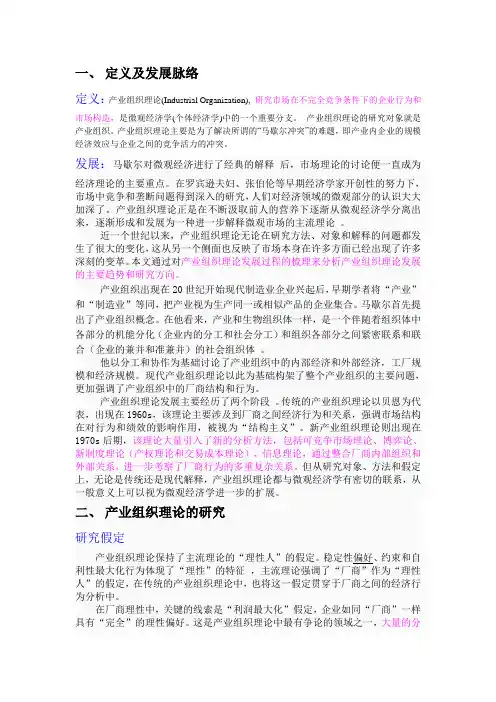
一、定义及发展脉络定义:产业组织理论(Industrial Organization), 研究市场在不完全竞争条件下的企业行为和市场构造,是微观经济学(个体经济学)中的一个重要分支。
产业组织理论的研究对象就是产业组织。
产业组织理论主要是为了解决所谓的“马歇尔冲突”的难题,即产业内企业的规模经济效应与企业之间的竞争活力的冲突。
发展:马歇尔对微观经济进行了经典的解释后,市场理论的讨论便一直成为经济理论的主要重点。
在罗宾逊夫妇、张伯伦等早期经济学家开创性的努力下,市场中竞争和垄断问题得到深入的研究,人们对经济领域的微观部分的认识大大加深了。
产业组织理论正是在不断汲取前人的营养下逐渐从微观经济学分离出来,逐渐形成和发展为一种进一步解释微观市场的主流理论。
近一个世纪以来,产业组织理论无论在研究方法、对象和解释的问题都发生了很大的变化,这从另一个侧面也反映了市场本身在许多方面已经出现了许多深刻的变革。
本文通过对产业组织理论发展过程的梳理来分析产业组织理论发展的主要趋势和研究方向。
产业组织出现在20世纪开始现代制造业企业兴起后,早期学者将“产业”和“制造业”等同,把产业视为生产同一或相似产品的企业集合。
马歇尔首先提出了产业组织概念。
在他看来,产业和生物组织体一样,是一个伴随着组织体中各部分的机能分化(企业内的分工和社会分工)和组织各部分之间紧密联系和联合(企业的兼并和准兼并)的社会组织体。
他以分工和协作为基础讨论了产业组织中的内部经济和外部经济,工厂规模和经济规模。
现代产业组织理论以此为基础构架了整个产业组织的主要问题,更加强调了产业组织中的厂商结构和行为。
产业组织理论发展主要经历了两个阶段。
传统的产业组织理论以贝恩为代表,出现在1960s,该理论主要涉及到厂商之间经济行为和关系,强调市场结构在对行为和绩效的影响作用,被视为“结构主义”。
新产业组织理论则出现在1970s后期,该理论大量引入了新的分析方法,包括可竞争市场理论、博弈论、新制度理论(产权理论和交易成本理论)、信息理论,通过整合厂商内部组织和外部关系,进一步考察了厂商行为的多重复杂关系。
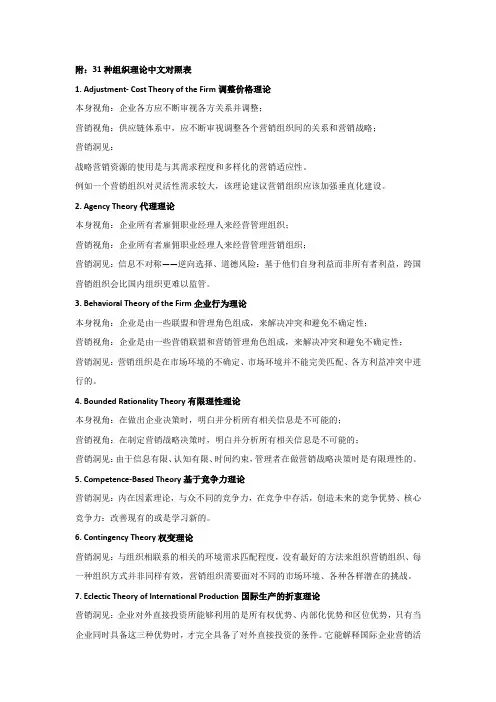
附:31种组织理论中文对照表1. Adjustment-Cost Theoryof the Firm调整价格理论本身视角:企业各方应不断审视各方关系并调整;营销视角:供应链体系中,应不断审视调整各个营销组织间的关系和营销战略;营销洞见:战略营销资源的使用是与其需求程度和多样化的营销适应性。
例如一个营销组织对灵活性需求较大,该理论建议营销组织应该加强垂直化建设。
2. AgencyTheory代理理论本身视角:企业所有者雇佣职业经理人来经营管理组织;营销视角:企业所有者雇佣职业经理人来经营管理营销组织;营销洞见:信息不对称——逆向选择、道德风险:基于他们自身利益而非所有者利益,跨国营销组织会比国内组织更难以监管。
3. BehavioralTheory ofthe Firm企业行为理论本身视角:企业是由一些联盟和管理角色组成,来解决冲突和避免不确定性;营销视角:企业是由一些营销联盟和营销管理角色组成,来解决冲突和避免不确定性;营销洞见:营销组织是在市场环境的不确定、市场环境并不能完美匹配、各方利益冲突中进行的。
4. BoundedRationalityTheory有限理性理论本身视角:在做出企业决策时,明白并分析所有相关信息是不可能的;营销视角:在制定营销战略决策时,明白并分析所有相关信息是不可能的;营销洞见:由于信息有限、认知有限、时间约束,管理者在做营销战略决策时是有限理性的。
5. Competence-BasedTheory基于竞争力理论营销洞见:内在因素理论,与众不同的竞争力,在竞争中存活,创造未来的竞争优势、核心竞争力:改善现有的或是学习新的。
6. ContingencyTheory权变理论营销洞见:与组织相联系的相关的环境需求匹配程度,没有最好的方法来组织营销组织、每一种组织方式并非同样有效,营销组织需要面对不同的市场环境、各种各样潜在的挑战。
7. EclecticTheory ofInternationalProduction国际生产的折衷理论营销洞见:企业对外直接投资所能够利用的是所有权优势、内部化优势和区位优势,只有当企业同时具备这三种优势时,才完全具备了对外直接投资的条件。
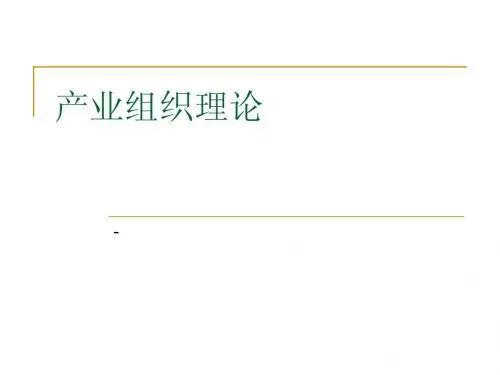
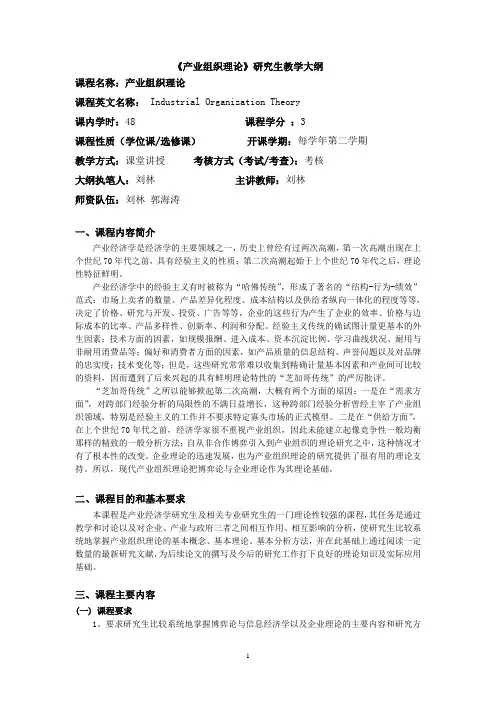
《产业组织理论》研究生教学大纲课程名称:产业组织理论课程英文名称: Industrial Organization Theory课内学时:48 课程学分:3课程性质(学位课/选修课)开课学期:每学年第二学期教学方式:课堂讲授考核方式(考试/考查):考核大纲执笔人:刘林主讲教师:刘林师资队伍:刘林郭海涛一、课程内容简介产业经济学是经济学的主要领域之一,历史上曾经有过两次高潮,第一次高潮出现在上个世纪70年代之前,具有经验主义的性质;第二次高潮起始于上个世纪70年代之后,理论性特征鲜明。
产业经济学中的经验主义有时被称为“哈佛传统”,形成了著名的“结构-行为-绩效”范式:市场上卖者的数量、产品差异化程度、成本结构以及供给者纵向一体化的程度等等,决定了价格、研究与开发、投资、广告等等,企业的这些行为产生了企业的效率、价格与边际成本的比率、产品多样性、创新率、利润和分配。
经验主义传统的确试图计量更基本的外生因素:技术方面的因素,如规模报酬、进入成本、资本沉淀比例、学习曲线状况、耐用与非耐用消费品等;偏好和消费者方面的因素,如产品质量的信息结构、声誉问题以及对品牌的忠实度;技术变化等;但是,这些研究常常难以收集到精确计量基本因素和产业间可比较的资料,因而遭到了后来兴起的具有鲜明理论特性的“芝加哥传统”的严厉批评。
“芝加哥传统”之所以能够掀起第二次高潮,大概有两个方面的原因:一是在“需求方面”,对跨部门经验分析的局限性的不满日益增长,这种跨部门经验分析曾经主宰了产业组织领域,特别是经验主义的工作并不要求特定寡头市场的正式模型。
二是在“供给方面”,在上个世纪70年代之前,经济学家很不重视产业组织,因此未能建立起像竞争性一般均衡那样的精致的一般分析方法;自从非合作博弈引入到产业组织的理论研究之中,这种情况才有了根本性的改变。
企业理论的迅速发展,也为产业组织理论的研究提供了很有用的理论支持。
所以,现代产业组织理论把博弈论与企业理论作为其理论基础。

1. The Theory of the Firm and Agency Problems★Coase, R., 1937, The nature of the firm, Economica4, 386 - 405★Alchian, A. and H. Demsetz, 1972, Production, information costs and economic organizations, American Economic Review, 777-795.★Williamson, O., 1971, The vertical integration of production: Market failure considerations, American Economic Review, 112-123.★Williamson, O., 1981, The modern corporation: Origins, evolution, attributes, Journal of Economic Literature, 1537-1568.Alchian, A. and S. Woodward, 1988, The firm is dead; Long live the firm: A review of OliverE. Williamson’s The Economic Institutions of Capitalism, Journal of Economic Literature,65-79.★Jensen, M. and W. Meckling, 1976, Theory of the Firm: Managerial Behavior, Agency Costs, and Ownership Structure, Journal of Financial Economics 3, 305- 360Fama, E. and M. Jensen, 1983, Separation of ownership and control, Journal of Law and Economics, 301-325Jensen, M., 1986, Agency Costs of Free Cash Flow, Corporate Finance and Takeovers, American Economic Review, 323-329.★Jensen, M. and W. Meckling, The Nature of Man, in The New Corporate Finance, 4-19. 2. Corporate Governance: Overview★Shleifer, Andrei and Robert Vishny, 1997, A Survey of Corporate Governance, Journal of Finance 52, 737-783.★La Porta, Rafael, Florencio Lopez-de-Salinas, Andrei Shleifer and Robert Vishny, 1999, Corporate Ownership Around the World, Journal of Finance 54(2), 471-520.★La Porta, Rafael, Florencio Lopez-de-Salinas, Andrei Shleifer and Robert Vishny, 1998, Law and Finance, Journal of Political Economy, 1113-1155.★Djankov, Simeon, La Porta, Rafael, Florencio Lopez-de-Salinas, and Andrei Shleifer, 2008, The Law and Economics of Self-dealing, Journal of Financial Economics, 430-465.★Bebchuk, Lucian and Assaf Hamdani, 2009, The Elusive Quest for Global Governance Standards, University of Pennsylvania Law Review, forthcoming.3. Corporate Governance and Capital MarketsShleifer, Andrei and Robert Vishny. 2000, Investor protection and corporate governance, Journal of Financial Economics 58, 3-27★Morck, Randall, Bernard Yeung, and Wayne Yu, 2000, The information content of stock markets: Why do emerging markets have synchronous stock price movements? Journal of Financial Economics 58, 215-260Jin, Li and Stewart Myers, 2006, R2 around the world: New theory and new tests, Journal of Financial Economics 79, 257 - 292.La Porta, Rafael, Florencio Lopez-de-Salinas, and Andrei Shleifer, 2006, What works in securities laws? Journal of Finance, 1-32.4. Corporate Governance and Firm Value★La Porta, Rafael, Florencio Lopez-de-Salinas, Andrei Shleifer and Robert Vishny, 2002, Investor protection and corporate valuation, Journal of Finance, 1147-1170.★Gompers, P., J. Ishii, and A. Metrick, 2003, Corporate governance and equity prices, Quarterly Journal of Economics, 107 – 155.★Core, J., W. Guay, and T. Rusticus, 2006, Does weak governance cause weak stock returns?An examination of firm operating performance and investors’ expectations, Journal of Finance, 655 – 687.★Morck, Randall, Andrei Shleifer and Robert Vishny, 1988, Management Ownership and Market Valuation: An Empirical Analysis, Journal of Financial Economics 20, 293-315.★McConnell, J. and H. Servas, 1990, Additional evidence on equity ownership and corporate value, Journal of Financial Economics 27, 595-613.★Cho, M.H., 1998, Ownership structure, investment, and corporate value: An empirical analaysis, Journal of Financial Economics 47, 103-121.Baek, J., J. Kang, and K. S. Park, 2004, Corporate governance and firm value: evidence from the Korean financial crisis, Journal of Financial Economics 71, 265-313.Doidge, C., G.A. Karolyi, and R. M. Stulz, 2004, Why are foreign firms listed in the U.S.worth more? Journal of Financial Economics 71, 205-238.Mitton, T., 2002, A cross-firm analysis of the impact of corporate governance on the East Asian financial crisis, Journal of Financial Economics 64, 215-241.Friedman, E., S. Johnson, and T. Mitton, 2003, Propping and tunneling, Journal of Comparative Economics 31, 732-750.Bae, K., J. Kang, and J. Kim, 2002, Tunneling or valued-added? Evidence from mergers by Korean business groups, Journal of Finance 57, 2695-2740.5. Asymmetric information and Capital market☆ Alchian, A., 1950, Uncertainty, Evolution, and Economic Theory, The Journal of Political Economy, 58 (3): 211-221.☆ Black, Fischer, 1986,Noise, The Journal of Finance, 41 (3): 529-543.☆Dequech, D. 1999, Expectations and Confidence under Uncertainty, Journal of Post Keynesian Economics, 21 (3): 415-430.○Chan, K., A.J. menkvel and Z. Yang, 2008, Information Asymmetry and Asset prices: Evidence from the China Foreign Share Discount, Journal of Finance.☆ Healy, Paul M., Krishna G. Palepu, 2001, Information asymmetry, corporate disclosure,and the capital markets: A review of the empirical disclosure literature, Journal of Accounting and Economics 31: 405-440.★ Francis, J., R. LaFond, P. Olsson and K. Schipper, 2003, Accounting Anomalies andInformation Uncertainty, Working paper.★ Attig, N., W. Fong, Y. Gadhoum and L. Lang, 2004, Effects of Large Shareholding onInformation Asymmetry and Stock Liquidity, Working paper.6. Information disclosure and corporate governance★ Botosan, Christine A., 1997, Disclosure Level and the Cost of Equity Capital, TheAccounting Review Vol72 (3): 323-349.★Botosan, C. A. And M. A. Plumlee, 2002, A Re-examination of disclosure Level and theExpected Cost of Equity Capital, Journal of Accounting Research vol. 40 (1).☆ Song, F. and A. V. Thakor, 2006, Information Control, Career Concerns, and CorporateGovernance, Journal of Finance (4).○ Gul F. and H. Qiu, Legal Protection, Corporate Governance and Information Asymmetryin Emerging Financial Markets, Working paper.☆ Bebchuk, L. 2002, Asymmetric information and the choice of corporate governancearrangements, Working paper.☆ Bushman, R.M. and A.J. Smith, 2003, Transparency, Financial Accounting Informationand Corporate Governance, FRBNY Economic Policy Review, 65-87.7. Large Shareholder, Liquidity and Stock Market☆ Bolton, P. and E. Thadden, 1998, Blocks, Liquidity, and Corporate Control, The Journal of Finance 53 (1): 1-25.☆ Demsetz, H. 1983, The structure of Ownership and the Theory of the Firm, Journal ofLaw and Economics, 26 (2): 375-390.☆ Shleifer A. and R.W. Vishny, 1986, Large Shareholders and Corporate Control, Journal of Political Economy, 94: 461-488.☆ Maug, E., 1998, Large Shareholders as Monitors: Is There a trade-Off Between Liquidityand Control? The Journal of Finance, Vol LIII: 65-98.★Parigi, B.M. and L. Pelizzon, 2007, Diversification and ownership concentration, Journal of Banking & Finance 32: 1743-1753.★ Maury, B. and A. pajuste, 2005, Multiple large shareholders and firm value, Journal ofBanking & Finance 29: 1813-1834.○Lemmon, M. and K. V. Lins, 2003, Ownership Structure, Corporate Governance, andFirm Value: Evidence from the East Asian Financial Crisis, The Journal of Finance, Vol.LVIII: 1145-1168.8. Political Connection, Regulations and Firm Value☆ Stigler, "What Can Regulators Regulate? The case of electricity", 1962, Journal of Law and Economics★ Stigler, George, “The Theory of Economic Regulation,” Bell Journal of Economics, I(Spring1971), 3-21.★ Blanchard, Olivier, and Shleifer, Andrei, “Federalism with and withoutPoliticalCentralization: China versus Russia,” manuscript, MIT and HarvardUniversity,February 2000.☆ Faccio, Mara, “Politically-Connected Firms: Can They Squeeze the State,” manuscript,University of Notre Dame, March 2002.★ Shleifer, Andrei and Robert Vishny, "Politicians and Firms," Quarterly Journal ofEconomics (109) 1994, 995-1025.☆ Bhattacharya, Utpal., Hazem Daouk, 2009, “When no law is better than a good law”,Working Paper.○Mingyi Hung TJ Wong and Tianyu Zhang, “Political Relations and Overseas StockExchange Listing: Evidence from Chinese State-owned Enterprises”, working paper.★ Fan, Wong and Zhang, 2007, Politically connected CEOs, corporate governance,andPost-IPO performance of China’s newly partially privatized firms, Journal of FinancialEconomics, 84, 330-357.9. Behavior Finance★ Nicholas Baeberis, and Richard Thaler, 2002. Survey of Behavioral Finance.○Graham, J.F., Harvey, C.R., 2001. The theory and practice of corporate finance: evidence from the field. Journal of Financial Economics 60, 187-243.★ Alti, A., 2006. How persistent is the impact of market timing on capital structure? Journal of Finance 61, 1681-1710.○ Baker, M., Wurgler, J., 2002. Market Timing and capital structure. Journal of Finance 57,1-32.○Kayhan, A., Titman, S., 2007. Firms’ histories and their capital structures. Journal ofFinancial Economics 83, 1-32.★ Fama, E.F., French, K.R., 2001. Disappearing dividends: changing firm characteristics or lower propensity to pay? Journal of Financial Economics 60, 3-43.○ DeAngelo, H., DeAngelo, L., Skinner, D.J., 2004. Are dividends disappearing? Dividendconcentration and the consolidation of earnings? Journal of Financial Economics 72, 425-456.★ Billett, M., Qian, Y., 2006. Are overconfident CEOs born or make? Evidence ofself-attribution bias from frequent acquirers. Unpublished working paper, Henry B, TippieCollege of Business, University of Iowa.○ Doukas, J., Petmezas, D., 2006. Acquisitions, overconfident managers and self-attributionbias.Unpublished working paper, Department of Finance, Graduate School of Business, OldDominion University.○ Malmendier, U., Tate, G., 2005. CEO overconfidence and corporate investment. Journal ofFinance 60, 2661-2700.10. The Board of DirectorsWeisbach, M., 1988, Outsider directors and CEO turnovers, Journal of Financial Economics 20, 431-460.Yermack, D., 1996, Higher market valuation of companies with a small board of directors, Journal of Financial Economics 40, 185-211.Rosenstein, S. and J. Wyatt, 1997, Inside Directors, Board Effectiveness, and Shareholder Wealth, Journal of Financial Economics 44, 229-250.Hermalin, B. and M. Weisbach, 1988, The determinants of board composition, Rand Journal of Economics 19, 589-606.Warner, J., R. Watts, and K. Wruck, 1988, Stock prices and top management changes, Journal of Financial Economics 20, 461-492.Johnson, Bruce, Robert Magee, Nandu Nagarajan and Henry Newman, 1985, An Analysis of the Stock Price Reaction to Sudden Executive Deaths: Implications for the Management Labor Model, Journal of Accounting and Economics 7, 151-174.11. Talent, Incentives, and Executive CompensationsBaumol, W., 1990, Entrepreneurship: Productive, Unproductive, and Destructive, Journal of Political Economy 98, 893-921.Murphy, K., A. Shleifer, and R. Vishny, 1991, The allocation of talent: Implications for growth, Quarterly Journal of Economics, 503-530.Jensen, Michael, and Kevin Murphy, 1990, Performance Pay and Top Management Incentives, Journal of Political Economy 98, 225-264.Core, John, Robert Holthausen and David Larcker, 1999, Corporate Governance, Chief Executive Officer Compensation, and Firm Performance, Journal of Financial Economics 51, 371-406.Rose, Nancy, and Andrea Shepard, 1997, Firm Diversification and CEO Compensation: Managerial Ability or Executive Entrenchment? RAND Journal of Economics 28, 489-514. 12. Corporate RestructuringDesai, H. and P. Jain, 1999, Firm performance and focus: Long-run stock market performance following spinoffs, Journal of Financial Economics 54, 75-101.Daley, L., V. Mehrotra and R. Sivakumar, 1997, Corporate focus and value creation: Evidence from spinoffs, Journal of Financial Economics 45, 257-281.Chen, P., V. Mehrotra, R. Sivakumar, and W. Yu, 2001, Layoffs, shareholders’ wealth, and corporate performance, Journal of Empirical Finance 8, 171-199.Servaes, H., 1996, The Value of Diversification During the Conglomerate Merger Wave, Journal of Finance 51, 1201-1225.Berger, P. and E. Ofek, 1996, Bustup Takeovers of Value-Destroying Diversified Firms,Journal of Finance 51, 1175-1200.Lamont, O. A. and C. Polk, 2002, Does diversification destroy value? Evidence from the industry shocks, Journal of Financial Economics 63, 51-77.Gillian, S., J. Kensinger, and J. Martin, 2000, Value creation and corporate diversification: the case of Sears, Roebuck & Co., Journal of Financial Economics 55, 103-137.Cusatis, P., J. Miles and J. Woolridge, Some new evidence that spinoffs create value, in NCF, 592-599.Mansi, S and D. M. Reeb, 2002 Corporate diversification: What gets discounted, Journal of Finance, 2167-2183Graham J. R., M. L. Lemmon and J. G. Wolf, 2002, Does corporate diversification destroy value? Journal of Finance , LVII, 695-720.Schoar, A, 2002, Effects of corporate diversification on productivity, Journal of Finance, LVII, 2379-2403.Campa, J. M. and S. Kedia, 2002, Explaining the diversification discount, Journal of Finance, 1731-1762.Aggarwal, R. and A. A. Samwick, 2003, Why do managers diversify their firms? Agency reconsidered. Journal of Finance, LVIII, 71-118.13. Risk ManagementGuay, W.R., 1999, The impact of derivatives on Þrm risk: An empirical examination of new derivative, Journal of Accounting and Economics 26 , 319-351Allayannis, G., and Weston, J.P., 2001, The use of foreign currency derivatives and firm market value, The Review of Financial Studies 14, 243-276.Guaya, W., and Kothari, S.P., 2003, How much do firms hedge with derivatives? Journal of Financial Economics 70, 423–461.Tufano, P., 1996, Who manage risks: An empirical examination of risk manage practices in gold mining industry, The Journal of Finance, 1097-1137.。